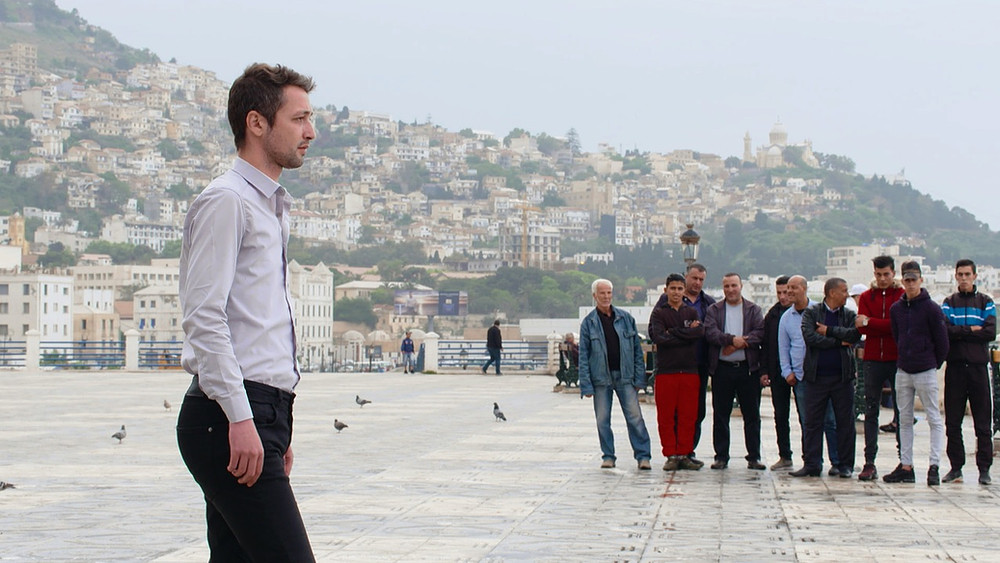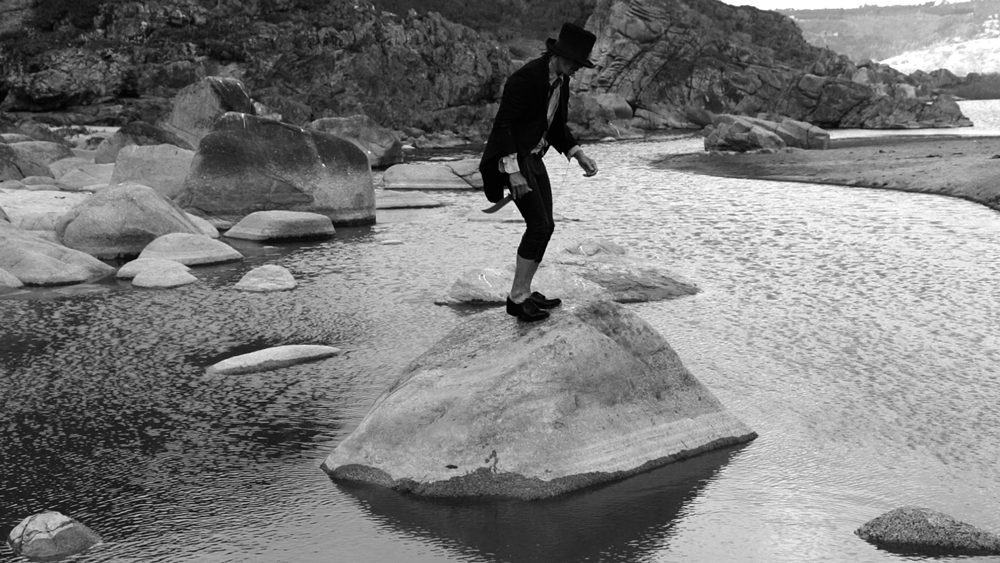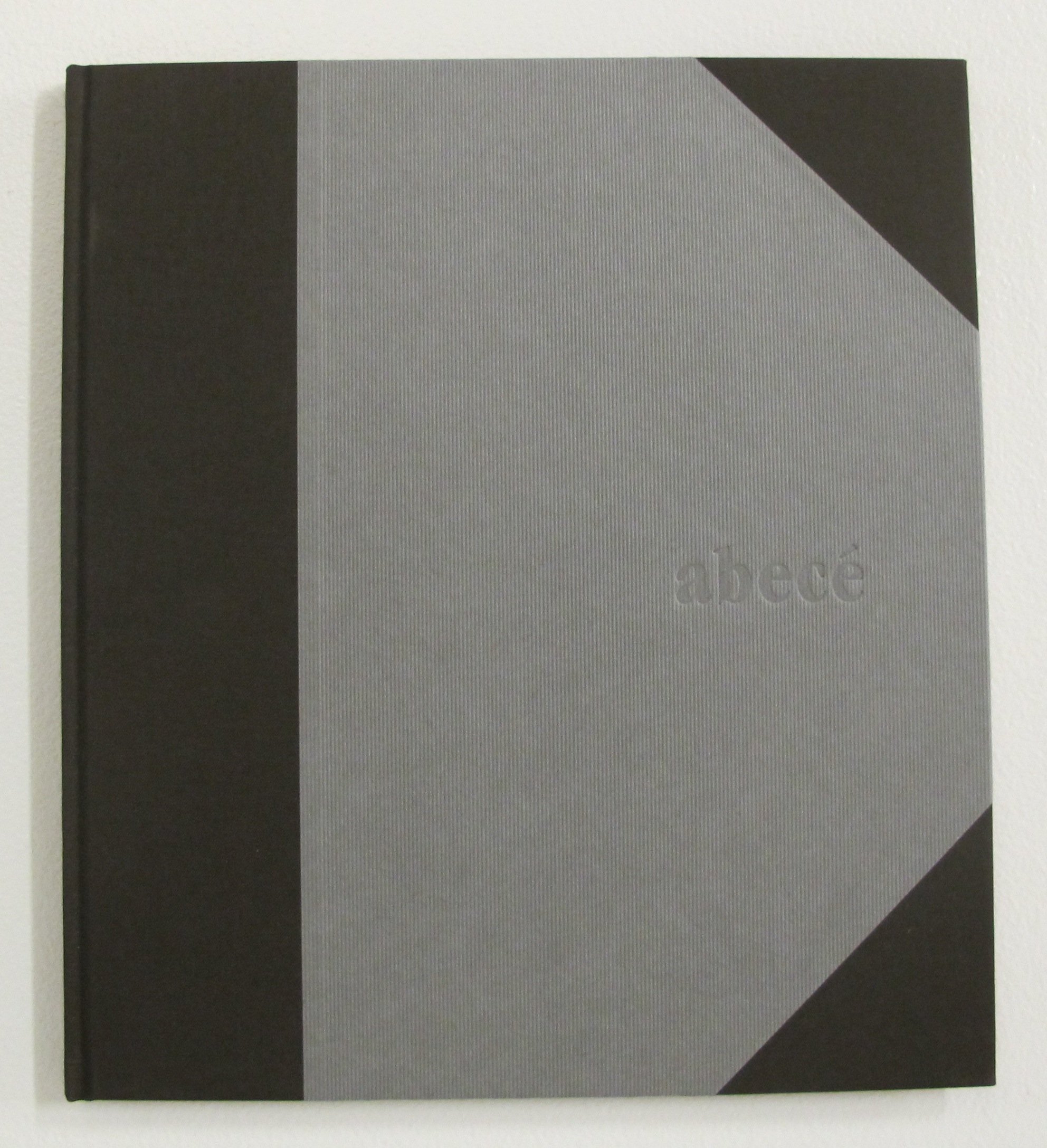
© » KADIST
Carole Douillard & Babette Mangolte
Following Bruce Nauman’s seminal performance Walking in an Exaggerated Manner Around the Perimeter of a Square (1967) – which sees the artist carefully trace a small delimited area of his studio exaggerating the movements of his hips as he places one foot in front of the other – Idir reproduces these performative gestures in Algiers, Algeria. Idir continues the artist’s previous work on ‘hittistes’, which translates as someone who spends their day with their back to the wall, the city’s unemployed and the gestures proper to them. In collaboration with cinematographer Babette Mangolte, Carole Douillard’s performance takes place across three emblematic sites within the city: Bab El Oued, Les Sablettes and Diar Es Saâda.

© » KADIST
Carlos Amorales
Drawing & Print (Drawing & Print)
Produced on the occasion of an exhibition at ARTIUM of Alava, Basque Centre-Museum of Contemporary Art, this deck of cards is a selection of images from Carlos Amorales’s Liquid Archive. and abstract silhouetted motifs, in a black and white palette, are combined to create a world lodged between fantasy and reality typical of the tarot game. Airplanes, letters, naked women, Osama Bin Laden, Che Guevara, mythological figures, skulls, wrestlers’ masks are some of the visuals that populate this printed object.

© » KADIST
Carlos Amorales
This work, a large oil painting on canvas, shows a moment from Amorales’s eight-minute two-channel video projection Useless Wonder (2006). The video is based on Edgar Allen Poe’s 1838 novel The Narrative of Arthur Gordon Pym of Nantucket. The painting, derived from an image from a different, preexisting work, represents the artist’s continued interest in realizing particular subject matter in alternative forms, thereby imbuing it with new meanings and interpretations.

© » KADIST
Caroline Déodat
Landslides is a cinematographic essay/poem by Caroline Déodat in which fictional images are the result of research into the memories of a Mauritian dance born during colonial slavery, the Sega. In the film, the contemporary Mauritian dancer Jean-Renat Anamah crosses mythical landscapes of the Sega that merge with intimate territories. From the pixels of the digital image and the signals of electronic music, this film exhumes in layers of landscapes the spectres of a ritual erased by history through a personal genealogy: between haunting memory and deferred archive.

© » KADIST
Carlos Amorales
Carlos Amorales, based in Mexico City, works in many media and combinations thereof, including video, drawing, painting, photography, installation, animation, and performance. Central in his work is the construction and alteration of what he calls his Liquid Archive, a collection of images, narratives, drawings, shapes, and ideas that he uses to construct his unique visual language—a critical and stimulating space for fantasy, reality, and the blurring of the two. Amorales creates tensions between revealing and hiding the personal and the universal in his often-ambiguous and fluid constructions.

© » KADIST
Carlos Fernández
Part of the exhibition PIÑA MATRIZ (2014) at Despacio Art, this untitled work by Carlos Fernández is a wood panel (formerly a section of a wooden table top) that bears the residue of insects interacting with fermented pineapple. The exhibition considered the production of pineapple monocultures and the agricultural monopolies for this product. Fernández used the exhibition space to portray alternative possibilities of diversified and ecologically sustainable production that could be mobilized in place of mass produced pineapple monocultures.

© » KADIST
Yoan Capote
Open Mind is a model created by Capote for a traversable public maze that, when seen from above, resembles the human brain. Because individual movement through the maze echoes the movement of neurons and a larger aggregated whole, visitors can be seen to enact a model of sociality and public space that both embodies and metaphorizes social consciousness. Capote’s model shows not just the proposed structure, but features figurines as well, to illustrate the possible scale and interactivity of the final piece.

© » KADIST
Carlos Motta
Searching for We’wha is composed of five photographic triptychs combining photographs from the American West (New Mexico and Arizona) with excerpts from American Indian poetry in an attempt to reconstruct imaginary aspects of the life of We’Wha, a famous member of the Zuni tribe, who was born male but who lived a feminine gender expression. With this work, Carlos Motta aims to question gender fluidity, indeterminacy, neutrality and non-conformity, using We’wha as an image of the ways in which Two-Spirit American Indians express gender in non-Western non-traditional ways. They are often accepted and revered by their tribes, and in We’wha’s case she even became an official representative of their social interests.

© » KADIST
Carla Zaccagnini
This series of photographs, Sobre la igualdad y las diferencias: casas gemelas (On Equality and Differences: Twin Houses) , taken in Havana in 2005, belongs to a wider group of works that the artist has been developing over many years, generally titled Bifurcaciones y encrucijadas (Forking Paths and Crossroads) . These works are dedicated to the collection and investigation of similarities and singularities. Some focus on things that are supposed or expected to be identical, but end up being slightly different.

© » KADIST
Johanna Calle
Drawing & Print (Drawing & Print)
Calle’s drawings all inhabit received forms but alter them to call attention to specific qualities. A newspaper is both reproduced and modified to call attention to the newspaper as a means of information transmission. This also emphasizes the effect of various seemingly unimportant support mechanisms: the role of visual layout and images.

© » KADIST
Carlos Garaicoa
From the series the Old and the New (XI) by Carlos Garaicoa belongs to the series Lo viejo y lo nuevo / Das Alte und das Neue (The Old and the New) which was first exhibited in 2010 at Barbara Gross Gallery in Germany. Here, Garaicoa’s interest in vernacular Cuban architecture shifts towards the European context: a series of twelve nineteenth-century French engravings have been reworked into delicate paper models. Here, the two-dimensional old-school architectural renderings have become the foundation for new hollow three-dimensional structures.

© » KADIST
Carolyn Drake
Megan and Hazel Sue at Creekmore House by Carolyn Drake is from a series of works titled Knit Club . For this project, Drake collaborated with an enigmatic group of women in Mississippi who loosely call themselves “Knit Club”. The subject matter of this photograph centers on the relationship between the girl and doll in the painting, and the woman and girl in the photograph.

© » KADIST
Carolyn Lazard
Between 1951 and 1974, Dr. Albert M. Kligman, a professor of dermatology at the University of Pennsylvania, oversaw medical experiments conducted on incarcerated people at Holmesburg Prison in Philadelphia. These nontherapeutic tests ranged from athlete’s foot powders, dandruff shampoos, deodorants, and detergents, as well as more hazardous materials such as dioxin, radioactive isotopes, and mind-altering psychotropics. During his tenure at Holmesburg, Dr. Kligman worked for companies such as Johnson & Johnson, developing the acne medicine Retin-A, and for Dow Chemical Company and the U. S. Department of Defence, testing the ‘tactical herbicide’ Agent Orange.

© » KADIST
Carolyn Drake
Jackie and Chloe by Carolyn Drake is from a series of works titled Knit Club . For this project, Drake collaborated with an enigmatic group of women in Mississippi who loosely call themselves “Knit Club”. There is a strangeness to this photograph; details of facial identity are withheld.

© » KADIST
Carlos Amorales
This work, a large oil painting on canvas, shows a moment from Amorales’s eight-minute two-channel video projection Useless Wonder (2006). The video is based on Edgar Allen Poe’s 1838 novel The Narrative of Arthur Gordon Pym of Nantucket . The painting, derived from an image from a different, preexisting work, represents the artist’s continued interest in realizing particular subject matter in alternative forms, thereby imbuing it with new meanings and interpretations.

© » KADIST
Juan Carlos Alom
In Amantes (Lovers) Juan Carlos points his lens at his own environment, his underground (literally) studio in Havana. A beautiful and intimate image of a seedy yet casual scene of two lovers in the background foreshadowed by a beautiful young woman smoking a joint in the foreground, a very powerful and not too subtle political representation of the current realities and truth of youth life in Havana. Juan Carlos Alom is an artist known for his documentary photography of Cuba’s subcultures and underground scenes.

© » KADIST
Johanna Calle
Drawing & Print (Drawing & Print)
Johanna Calle’s Abece “K” (2011) is part of a series of drawings (compiled into an artist book called Abece ) based on the alphabet. There is a drawing for each letter, in which the letter is repeated over and again in various directions and scales, thereby demonstrating how a symbol can be reoriented without changing its linguistic meaning. Here, the letter K is outlined and surrounded by a dense and varied field of other K s.

© » KADIST
Carla Zaccagnini
De sino à sina (From Bell to Fate) is a six-channel sound installation by Carla Zaccagnini exploring the relationship between modern Brazil and its colonial past. The sound installation is made from a recording of the bell at Capela de Nossa Senhora do Rosário dos Homens Brancos, a Baroque-style chapel that is one of the first chapels in Ouro Preto (previously Vila Rica) in the region of Minas Gerais. The work references the execution of José da Silva Xavier (1746-1792), also known as “Tiradentes”.

© » KADIST
Antonio Caro
Juego de Banderas (a play on words that loosely translates to both set of flags and game of flags) is a triptych of modified Colombian flags by Antonio Caro. Although the yellow, blue and red stripes on the first flag are faithful to the original, the second flag at the center has been modified to feature the word Colombia, emulating the typography and white-on-red design of the iconic Coca-Cola brand. Caro’s first version of this logo was a 1976 graphite drawing, and he has since produced several variations in different materials.
Carlos Amorales
- year born: 1970
- gender: male
- nationality: Mexican
- home town: Mexico City, Mexico
Johanna Calle
- location: Bogota, Colombia
- year born: 1965
- nationality: Colombian
- home town: Bogota, Colombia
Carla Zaccagnini
- year born: 1973
- gender: female
- nationality: Brazilian
- home town: Buenos Aires, Argentina
Carolyn Drake
Carolyn Drake works on long term photo-based projects that involve travel and collaboration...
Antonio Caro
- location: Bogotá, Colombia
- year born: 1950
- gender: male
- nationality: Colombian
Carolyn Lazard
Carolyn Lazard’s practice centers disability and accessibility through sculpture, video, installation, and performance...
Carlos Motta
Carlos Motta’s is a multi-disciplinary artist whose work seeks to document the social conditions and political struggles of sexual, gender, and ethnic minority communities through a variety of variety of mediums including video, installation, sculpture, drawing, web-based projects, performance, and symposia...
Yoan Capote
- location: Havana, Cuba
- year born: 1977
- gender: male
- nationality: Cuban
Carole Douillard & Babette Mangolte
Carole Douillard Kabyle-French artist Carole Douillard uses the presence of figures, be it her own, or of performers, to produce sculptural works within space...
Carlos Garaicoa
- location: Madrid, Spain
- year born: 1967
- gender: male
- nationality: Cuban
- home town: Havana, Cuba
-
2000-2009
Johanna Calle
Drawing & Print
2003(Drawing & Print) Calle’s drawings all inhabit received forms but alter them to call attention to specific qualities...
Carlos Amorales
Drawing & Print
2005(Drawing & Print) Produced on the occasion of an exhibition at ARTIUM of Alava, Basque Centre-Museum of Contemporary Art, this deck of cards is a selection of images from Carlos Amorales’s Liquid Archive...
Carla Zaccagnini
2005This series of photographs, Sobre la igualdad y las diferencias: casas gemelas (On Equality and Differences: Twin Houses) , taken in Havana in 2005, belongs to a wider group of works that the artist has been developing over many years, generally titled Bifurcaciones y encrucijadas (Forking Paths and Crossroads) ...
Carlos Amorales
2006This work, a large oil painting on canvas, shows a moment from Amorales’s eight-minute two-channel video projection Useless Wonder (2006)...
Carlos Amorales
2007This work, a large oil painting on canvas, shows a moment from Amorales’s eight-minute two-channel video projection Useless Wonder (2006)...
Yoan Capote
2007Open Mind is a model created by Capote for a traversable public maze that, when seen from above, resembles the human brain...
-
2010-2019
Carlos Garaicoa
2010From the series the Old and the New (XI) by Carlos Garaicoa belongs to the series Lo viejo y lo nuevo / Das Alte und das Neue (The Old and the New) which was first exhibited in 2010 at Barbara Gross Gallery in Germany...
Johanna Calle
Drawing & Print
2011(Drawing & Print) Johanna Calle’s Abece “K” (2011) is part of a series of drawings (compiled into an artist book called Abece ) based on the alphabet...
Juan Carlos Alom
2012In Amantes (Lovers) Juan Carlos points his lens at his own environment, his underground (literally) studio in Havana...
Carlos Amorales
2014Carlos Amorales, based in Mexico City, works in many media and combinations thereof, including video, drawing, painting, photography, installation, animation, and performance...
Carlos Fernández
2014Part of the exhibition PIÑA MATRIZ (2014) at Despacio Art, this untitled work by Carlos Fernández is a wood panel (formerly a section of a wooden table top) that bears the residue of insects interacting with fermented pineapple...
Carlos Motta
2014Searching for We’wha is composed of five photographic triptychs combining photographs from the American West (New Mexico and Arizona) with excerpts from American Indian poetry in an attempt to reconstruct imaginary aspects of the life of We’Wha, a famous member of the Zuni tribe, who was born male but who lived a feminine gender expression...
Antonio Caro
2016Juego de Banderas (a play on words that loosely translates to both set of flags and game of flags) is a triptych of modified Colombian flags by Antonio Caro...
Carole Douillard & Babette Mangolte
2018Following Bruce Nauman’s seminal performance Walking in an Exaggerated Manner Around the Perimeter of a Square (1967) – which sees the artist carefully trace a small delimited area of his studio exaggerating the movements of his hips as he places one foot in front of the other – Idir reproduces these performative gestures in Algiers, Algeria...
Carolyn Drake
2018Megan and Hazel Sue at Creekmore House by Carolyn Drake is from a series of works titled Knit Club ...
Carla Zaccagnini
2018De sino à sina (From Bell to Fate) is a six-channel sound installation by Carla Zaccagnini exploring the relationship between modern Brazil and its colonial past...
-
2020-2029
Caroline Déodat
2020Landslides is a cinematographic essay/poem by Caroline Déodat in which fictional images are the result of research into the memories of a Mauritian dance born during colonial slavery, the Sega...
